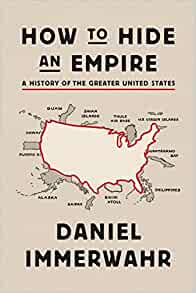 Daniel Immerwahr, How to Hide an Empire: A History of the Greater United States (New York: Farrar, Straus, and Giroux, 2019), 516pp.
Daniel Immerwahr, How to Hide an Empire: A History of the Greater United States (New York: Farrar, Straus, and Giroux, 2019), 516pp.
I read this book because I'm interested in the subject of American exceptionalism (whatever that means), and also because of the effusive recommendation on the back cover by one of my favorite authors. "There are many histories of American expansionism," writes Andrew Bacevich. "How to Hide an Empire renders them all obsolete. It is brilliantly conceived, utterly original, and immensely entertaining — simultaneously vivid, sardonic, and deadly serious." The book is a bit long, but I was not in the least bit disappointed. Immerwahr, an associate professor of history at Northwestern University, has written an important book about an important subject.
When most of us think about a map of the United States, what our country looks like, we almost always imagine what Immerwahr calls the "logo map" (a term coined by Benedict Anderson) — that is, a silhouette of the lower forty-eight states. In fact, this default mental map is grossly misleading. The logo map often doesn't even include Hawaii or Alaska. Nor does it include Puerto Rico, which has been part of the United States since 1899. You won't see American Samoa, Guam, or the Virgin Islands. And you sure won't see the nearly 100 islands claimed or controlled by the United States around the year 1940. Incredibly, at the end of World War II, the American mainland had a population of about 132 million, but that was dwarfed by the "colonized population" of 135 million people who lived in the U.S.'s many territories, possessions, commonwealths, mandates, dominions, and "strategic trusts" like Micronesia. And whereas those days of territorial domination have today given way to what you might call technological annexation, most people have no idea that today the United States maintains a "planetary presence" with over 800 military bases around the globe. Britain and France have a combined 13 overseas bases. Russia has nine.
So, Immerwahr's book is really about his subtitle: he wants us to move beyond the misleading logo map by documenting the history of the "greater United States" since its "buoyantly expansionist" early days until now. This is a lost history to most of us, one about which we are ignorant or indifferent. Consider, for example, that the US conquest of the Philippines from 1899 to 1903 killed more people than those who died in the Civil War, or that some 1.6 million people died in the Philippines in World War II, making it "by far the most destructive event ever to take place on U.S. soil."
In 1901, Britain began to celebrate an official holiday called "Empire Day." Since 1958 it has been called "Commonwealth Day." Americans, on the other hand, have always been deeply ambivalent about its own empire. Immerwahr's book helps to show how and why that's the case.
For more on American empire, see our JWJ archives for my reviews of the books by Andrew Bacevich, Chalmers Johnson, Wes Avram, Fareed Zakaria, and Cullen Murphy.
Dan Clendenin: dan@journeywithjesus.net


